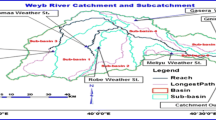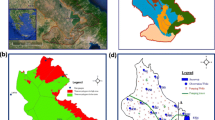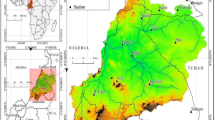Abstract
Measures taken to cope with the possible effects of climate change on water resources management are key for the successful adaptation to such change. This work assesses the environmental water demand of the Karkheh river in the reach comprising Karkheh dam to the Hoor-al-Azim wetland, Iran, under climate change during the period 2010–2059. The assessment of the environmental demand applies (1) representative concentration pathways (RCPs) and (2) downscaling methods. The first phase of this work projects temperature and rainfall in the period 2010–2059 under three RCPs and with two downscaling methods. Thus, six climatic scenarios are generated. The results showed that temperature and rainfall average would increase in the range of 1.7–5.2 and 1.9–9.2%, respectively. Subsequently, flows corresponding to the six different climatic scenarios are simulated with the unit hydrographs and component flows from rainfall, evaporation, and stream flow data (IHACRES) rainfall-runoff model and are input to the Karkheh reservoir. The simulation results indicated increases of 0.9–7.7% in the average flow under the six simulation scenarios during the period of analysis. The second phase of this paper’s methodology determines the monthly minimum environmental water demands of the Karkheh river associated with the six simulation scenarios using a hydrological method. The determined environmental demands are compared with historical ones. The results show that the temporal variation of monthly environmental demand would change under climate change conditions. Furthermore, some climatic scenarios project environmental water demand larger than and some of them project less than the baseline one.














Similar content being viewed by others
References
Ahmadi, M., Bozorg-Haddad, O., & Loáiciga, H. A. (2015). Adaptive reservoir operation rules under climatic change. Water Resources Management, 29(4), 1247–1266.
Arthington, A.H., Lorenzen, K., Pusey, B.J., Abell, R., Halls, A.S., Winemiller, K.O., Arrington, D.A., and Baranm E. (2003). "River fisheries: ecological basis for management and conservation." Proceedings of the Second International Symposium on the Management of Large Rivers for Fisheries, Phnom Penh, Kingdom of Combodia, 11–14 February.
Ashofteh, P., Bozorg-Haddad, O., & Mariño, M. A. (2013). Climate change impact on reservoir performance indexes in agricultural water supply. Journal of Irrigation and Drainage Engineering, 139(2), 85–97.
Burlando, P., & Rosso, R. (2002). Effects of transient climatic change on basin hydrology. 2. Impacts on runoff variability in the Arno river, central Italy. Journal of Hydrological Processes, 16(6), 1177–1199.
Croke, B.F.W. and Jakeman, A.J. (2008). "Use of the IHACRES rainfall-runoff model in arid and semi arid regions." Workshop of the National Institute of Hydrology, Roorkee, India, 28 February- 5 March.
Fujino, J., Nair, R., Kainuma, M., Masui, T., and Matsuoka, Y. (2006). "Multi-gas mitigation analysis on stabilization scenarios using aim global model." Energy Journal, 343–353.
Githui, F., Gitau, W., Mutua, F., & Bauwens, W. (2009). Climate change impacts on SWAT simulated streamflow in western Kenya. International Journal of Climatology, 29(12), 1823–1834.
Intergovernmental Panel on Climate Change. (2007). Climate change 2007: the physical science basis-working group I contribution to the fourth assessment report of the Intergovernmental Panel on Climate Change. Cambridge: Cambridge University Press.
Intergovernmental Panel on Climate Change. (2014). Climate change 2014: impacts, adaptation and vulnerability-regional aspects. Cambridge: Cambridge University Press.
Jamali, S., Abrishami, A., Mariño, M., and Abbasnia, A. (2012). "Climate change impacts assessment on hydrology of Karkheh basin, Iran." Proceeding of the Institution of Civil Engineers-Water Management, 166(2), 93–104.
Kashaigili, J. J., Mccartney, M., & Mahoo, H. (2007). Estimation of environmental flows in the Great Ruaha river catchment, Tanzania. Journal of Physics and Chemistry of the Earth, 32(15–18), 1007–1014.
King, J., & Louw, D. (1998). Instream flow assessments for regulated rivers in South Africa using the Building Block Methodology. Journal of Ecosystem Health and Management, 1, 109–124.
King, J., Brown, C., & Sabet, H. (2003). A scenario-based holistic approach to environmental flow assessments for rivers. Journal of River Research and Applications, 19(5–6), 619–639.
Linnansaari, T., Monk, W.A., Baird, D.J., and Curry, R.A. (2012). "Review of approaches and methods to assess environmental flows across Canada and internationally." Fisheries and Oceans Canada science.
Liu, J., Liu, Q., & Yang, H. (2016). Assessing water scarcity by simultaneously considering environmental flow requirements, water quantity and water quality. Journal of Ecological Indicators, 60, 434–441.
Loáiciga, H. A. (2003). Climate change and groundwater. Annals of the Association of American Geographers, 93(1), 33–45.
Loáiciga, H. A., Maidment, D., & Valdes, J. B. (2000). Climate change impacts in a regional karst aquifer, Texas, USA. Journal of Hydrology, 227, 173–194.
Mazvimavi, D., Madamombe, E., & Makurira, H. (2007). Assessment of environmental flow requirements for river basin planning in Zimbabwe. Journal of Phisics and Chemistry of the Earth, 32(15–18), 995–1006.
Milhous, R. T., Updike, M. A., & Schneider, D. M. (1989). Physical habitat simulation system reference manual-version 2. Washington: National Ecology Research Center, Fish and Wildlife Service.
Minville, M., Krau, S., Brissette, F., & Leconte, R. (2010). Behaviour and performance of a water resource system in Québec (Canada) under adapted operating policies in a climate change context. Journal of Water Resources Management, 24(7), 1333–1352.
Ngoc, D., Geurbesville, P., Minh, T., Raghavan, S., & Shie, Y. (2016). A deterministic hydrological approach to estimate climate change impact on river flow: Vu Gia-Thu Bon catchment, Vietnam. Journal of Hydro-Environment Research, 11, 59–74.
Oyebode, O., Adeyemo, J., & Otieno, F. (2014). Uncertainties sources in climate change impact modeling of water resources systems. Academic Journal of Science, 3(2), 245–260.
Qian, W., & Zhu, Y. (2001). Climate change in China from 1880 to 1998 and its impact on the environmental condition. Journal of Climatic Change, 50(4), 419–444.
Reinfelds, I., Haeusler, T., Brooks, A. J., & Williams, S. (2004). Refinement of the wetted perimeter breaakpoint method for setting cease-to-pump limits or minimum environmental flows. River Research and Applications, 20(6), 671–685.
Riahi, K., Rao, S., Krey, V., Cho, C., Chirkov, V., Fischer, G., Kindermann, G., Nakicenovic, N., and Rafaj, P. (2011). "RCP 8.5- a scenario of comparatively high greenhouse gas emissions." Journal of Climatic Change, 33–109.
Richter, B., Baumgartner, J., Wigington, R., & Braun, D. (1997). How much water does a river need? Journal of Freshwater Biology, 37(1), 231–249.
Tennant, D.L. (1976). "Instream flow regimens for fish, wildlife, recreation and related environmental resources." Journal of Fisheries, 1(4).
Tessman, S. A. (1980). Environmental assessment, technical appendix E, in environmental use sector reconnaissance elements of the Western Dakotas Region of South Dakota Study. Brookings: Water Resources Research Institute, South Dakota State University Reconnaissance Elements of the Western Dakotas Region of South Dakota Study.
Tharme, R. E. (2003). A global perspective on environmental flow assessment: emerging trends in the development and application of environmental flow methodologies for rivers. Journal of River Research and Applications, 19(5–6), 397–441.
Thodsen, H. (2007). The influence of climate change on stream flow in Danish rivers. Journal of Hydrology, 333(2–4), 226–238.
Thomson, A.M., Calvin, K.V., Smith, S.J., Page Kyle, G., Volke, A., Patel, P., Delgado-Arias, S., Bond-Lamberty, B., Wise, M.A., Clarke, L.E., and Edmonds, J.A. (2011). "RCP 4.5: a pathway for stabilization of radiative forcing by 2100." Journal of Climatic Change, 77–109.
Van-Vuuren, D., Edmonds, J., Kainuma, M., Riahi, K., Thomson, A., Hibbard, K., Hurtt, G., Kram, T., Krey, V., Lamarque, J. F., Masui, T., Meinhausen, M., Nakicenovic, N., Smith, S., & Rose, S. K. (2011). The representative concentration pathways: an overview. Journal of Climate Change, 109, 5–31.
Wayne, G.P. (2013). "The beginner’s guide to representative concentration pathways." Skeptical Science.
Wilby, R.L. and Harris, I. (2006). "A framework for assessing uncertainties in climate change impact: low-flow scenarios for the river Thames, UK." Water Resources Research, 42(2).
Wilby, R. L., Dawson, C. W., & Barrow, E. M. (2002). SDSM—a decision support tool for the assessment of regional climate change impacts. Environmental Modelling & Software, 17(2), 147–159.
Yin, X. A., Mao, X. F., Pan, B. Z., & Zhao, Y. W. (2015). Suitable range of reservoir storage capacities for environmental flow provision. Journal of Ecological Engineering, 76, 122–129.
Author information
Authors and Affiliations
Corresponding author
Rights and permissions
About this article
Cite this article
Sarzaeim, P., Bozorg-Haddad, O., Fallah-Mehdipour, E. et al. Environmental water demand assessment under climate change conditions. Environ Monit Assess 189, 359 (2017). https://doi.org/10.1007/s10661-017-6067-3
Received:
Accepted:
Published:
DOI: https://doi.org/10.1007/s10661-017-6067-3




